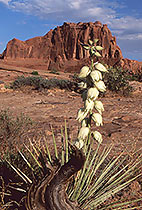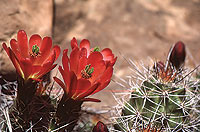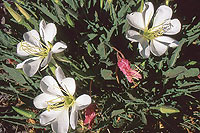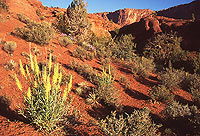 Spring is a magical time in the desert. During this time of year, the landscape of incredible geologic formations: the arches, bridges, canyons, standing rocks, high plateaus, and mountain ranges, becomes more spectacular as a procession of wildflowers begins to bloom.
Spring is a magical time in the desert. During this time of year, the landscape of incredible geologic formations: the arches, bridges, canyons, standing rocks, high plateaus, and mountain ranges, becomes more spectacular as a procession of wildflowers begins to bloom.
These early-season wildflowers represent several different groups of plants: annuals, perennials, and flowering shrubs. Though they share some similarities, their diversities are immense. And it is this variety of flower color, pollinator appeal, and seed production which makes things so interesting.
Annuals are plants that germinate and die within one season. Some annual examples include scorpionweed, yellow beeplant, and spectacle-pod with its eyeglasses-shaped seedpods. These plants produce seeds that may lie dormant for years, awaiting the proper conditions for germination. The seed coats, which protect the embryos, may have chemical inhibitors that prevent premature sprouting; these inhibitors generally break down when the moisture content or other conditions are sufficient to break this dormancy. Some seeds might require a period of scarification, a roughening of the seedcoat, to help it break down.
 Plants like lupines, also known as bluebonnets, eject their seeds at maturity. As the seedpods dry, they split longitudinally and twist, sometimes this snapping action is so loud that a passing hiker could hear it, as the action flings the seed far away from the mother plant. Lupines have tough seed coats and have been known to last over 30 years before germinating in a greenhouse setting.
Plants like lupines, also known as bluebonnets, eject their seeds at maturity. As the seedpods dry, they split longitudinally and twist, sometimes this snapping action is so loud that a passing hiker could hear it, as the action flings the seed far away from the mother plant. Lupines have tough seed coats and have been known to last over 30 years before germinating in a greenhouse setting.
 Perennials are flowering plants with a multi-year life span, their longevity dictated by herbivores, climate, and other conditions. These plants often have extensive root systems to gather moisture from the upper layers in the soil, and after flowering and seed production, die back to a small rosette of leaves or just their underground parts. Penstemons, biscuitroots, mule’s ears, woody asters, evening primroses, and sand verbenas are just a few of the many perennials that bloom in spring. Another type is known as bulbous perennials, due to their underground bulb, such as the Utah State flower Sego lily. The small onion-like bulb persists even though the above-ground stalks and leaves wither away later in the season.
Perennials are flowering plants with a multi-year life span, their longevity dictated by herbivores, climate, and other conditions. These plants often have extensive root systems to gather moisture from the upper layers in the soil, and after flowering and seed production, die back to a small rosette of leaves or just their underground parts. Penstemons, biscuitroots, mule’s ears, woody asters, evening primroses, and sand verbenas are just a few of the many perennials that bloom in spring. Another type is known as bulbous perennials, due to their underground bulb, such as the Utah State flower Sego lily. The small onion-like bulb persists even though the above-ground stalks and leaves wither away later in the season.
Cacti are also perennials but fall into their own category as fleshy, spine-covered plants that maintain their mass, mostly, during the season. These plants can withstand periods of drought that might otherwise kill other plants. Whipple’s fishhook and claret cup cactus, with their brilliant red flowers, are two common cacti that produce spectacular blooms in the spring, while the prickly pear cactus blooms more towards the start of summer.
 In addition to the wildflowers and cacti, numerous desert shrubs also produce colorful or fragrant flowers in the spring. Cliffrose, desert mahonia, serviceberry, and blackbrush may bear abundant flowers that cloak the shrubs. In the case of cliffrose, you’ll know when these plants are in bloom because you may smell them before your see them. These Rose-family members perfume the air with a sweet scent which draws in bees and other insects as pollinators.
In addition to the wildflowers and cacti, numerous desert shrubs also produce colorful or fragrant flowers in the spring. Cliffrose, desert mahonia, serviceberry, and blackbrush may bear abundant flowers that cloak the shrubs. In the case of cliffrose, you’ll know when these plants are in bloom because you may smell them before your see them. These Rose-family members perfume the air with a sweet scent which draws in bees and other insects as pollinators.
And if you want to experience a unique desert wildflower event, find a patch of yucca in bloom. Then, in the evening, watch the flowers for small, half-inch long pronuba moths that crawl over and inside the creamy white flowers. These are the female moths and as they pollinate the flower then lay their eggs in a flower’s ovary which provides their developing larvae with a food source. Truly, a magical spring moment.